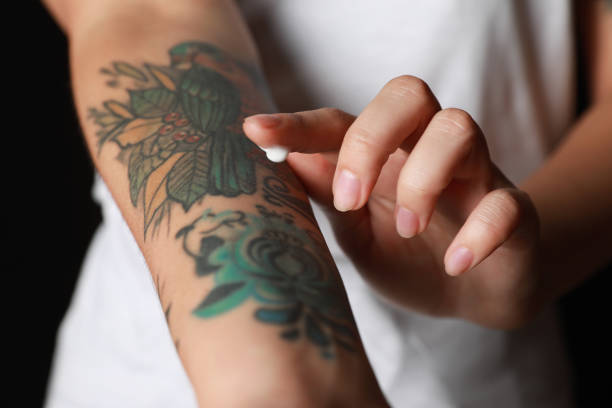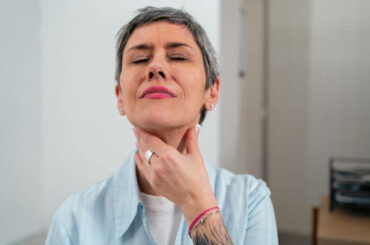Contents
Stages of Healthy Tattoo Healing

Healthy tattoo healing begins with the immediate post-tattoo care, which is crucial for setting the foundation of proper healing and ensuring the longevity of your new ink. Understanding the stages of healthy tattoo healing is key to ensuring that your new ink heals beautifully and maintains its vibrancy for years to come. From the immediate post-tattoo care to the final settling and appearance, each phase plays a crucial role in the overall outcome of your tattoo. Let’s delve into the stages of healthy tattoo healing and discover the essential steps to nurturing your new ink to perfection.
1.Immediate Post-Tattoo Care
This stage begins right after the tattooing process is completed. The tattoo artist will clean the tattooed area and apply a thin layer of ointment or specialized tattoo aftercare product to protect the skin and promote healing. Keeping the tattoo clean and dry during this time is crucial to prevent infection.
2.Initial Inflammation and Redness
In the first few days following the tattoo session, the tattooed area may be red, swollen, and tender to the touch. This is a natural response as the body initiates the healing process and begins to repair the skin.
3.Scabbing and Peeling
As the tattooed area starts to heal, it may develop scabs and begin to peel. This is the body’s way of shedding the damaged outer layers of skin to reveal the fresh tattoo beneath. It’s essential not to pick or scratch at the scabs, as this can disrupt the healing process and affect the final outcome of the tattoo.
4.Itchiness and Dryness
As the healing progresses, you may experience itchiness and dryness in the tattooed area. It’s important to resist the urge to scratch, as this can lead to irritation and potential infection. Instead, gently moisturize the tattooed skin to keep it hydrated and relieve discomfort.
5.Settling and Final Appearance
Over the course of several weeks, the tattoo will continue to settle as the skin fully heals. The colors may appear more vibrant, and any minor imperfections or uneven areas may smooth out. By the end of the healing process, typically within four to six weeks, your tattoo should have reached its final appearance.
Throughout the healing process, it’s essential to follow any specific aftercare instructions provided by your tattoo artist and to maintain good hygiene practices to prevent infection. By taking proper care of your tattoo during each stage of healing, you can ensure that it heals beautifully and retains its vibrancy for years to come.
The journey of healthy tattoo healing encompasses a series of stages, each playing a vital role in the overall outcome of your ink. From the immediate post-tattoo care to the final settling and appearance, proper attention and care are essential at every step. By following the guidance of your tattoo artist and practicing good hygiene habits, you can ensure that your tattoo heals beautifully, revealing its vibrant colors and intricate details. Remember, patience is key as your tattoo progresses through the stages of healing, and with diligence, you’ll soon be able to admire your ink in its full glory.
Aftercare Routine for Healthy Tattoo Healing

Healthy tattoo healing involves more than just getting inked – it’s about nurturing your new tattoo through its crucial stages of recovery. To ensure your tattoo heals beautifully and maintains its vibrancy, it’s essential to follow a proper aftercare routine. Here’s a simple guide outlining key steps to promote healthy tattoo healing
1. Keep it Clean
During the initial stage of healthy tattoo healing, make sure to keep the tattooed area clean. Gently wash the tattoo with mild, unscented soap and water to remove any excess ink, blood, or ointment. Blot it dry with a clean towel or let it air dry.
2. Moisturize Regularly
Keeping your tattooed skin adequately moisturized is crucial to prevent dryness and discomfort. Regularly apply a thin layer of fragrance-free, hypoallergenic moisturizer to the tattooed area to keep it hydrated and support healthy tattoo healing.
3. Avoid Sun Exposure
Shield your tattoo from direct sunlight while it heals. UV rays can fade colors and irritate the skin, hindering healthy tattoo healing. If you need to go outside, cover the tattooed area with clothing or use a broad-spectrum sunscreen with a high SPF.
4. Don’t Scratch or Pick
It’s natural for the tattooed skin to itch as it heals, but resist the urge to scratch or pick at it. This damages the process of healthy tattoo healing and increases the risk of infection. Instead, gently tap or pat the area to relieve itching.
5. Follow Your Artist’s Instructions
Your tattoo artist will provide you with specific aftercare instructions tailored to your tattoo. Follow their advice closely to ensure optimal healing. If you have any questions or concerns, don’t hesitate to reach out to them for guidance.
Healthy tattoo healing is a journey that requires diligence and care. By following these simple steps – keeping your tattoo clean, moisturizing regularly, avoiding sun exposure, resisting the urge to scratch or pick, and adhering to your artist’s instructions – you can promote optimal healing and ensure your tattoo retains its beauty for years to come. Remember, your tattoo artist is your ally in this process, so don’t hesitate to reach out to them for guidance whenever needed. With patience and proper aftercare, your tattoo will heal beautifully, allowing you to proudly display your new ink with confidence.
Identification of Infection Signs and Prevention for Healthy Tattoo Healing

Identification of infection signs and prevention are crucial aspects of ensuring healthy tattoo healing. Here’s some valuable information to help you recognize potential infection signs and take preventive measures:
Identification of Infection Signs
1. Increased Pain: While some discomfort is normal during the healing process, if you experience sudden or severe pain in the tattooed area, it could indicate an infection.
2. Excessive Redness: While redness is common in the initial stages of healing, if the redness becomes increasingly intense or spreads beyond the tattooed area, it may be a sign of infection.
3. Swelling: While some swelling is expected after getting a tattoo, persistent or worsening swelling might signal an underlying infection, requiring prompt attention.
4. Pus or Discharge: Any unusual discharge, especially if it’s yellow, green, or foul-smelling, could indicate an infection.
5. Heat: If the tattooed area feels unusually warm to the touch, it may be a sign of infection, as increased blood flow and inflammation can generate heat.
6. Fever or Chills: Systemic symptoms like fever or chills may indicate that the body is fighting off an infection, and medical attention should be sought immediately.
Prevention Measures:
1. Avoid Submerging in Water: During the initial healing period, avoid swimming pools, hot tubs, or soaking baths, as submerging the tattooed area in water can increase the risk of infection.
2. Monitor Healing Progress: Keep a close eye on the healing progress of your tattoo and watch for any signs of infection. If you notice anything unusual, consult a healthcare professional promptly.
3. Prevent Excessive Moisture: Exposing your tattoo to excessive moisture, such as sweating or prolonged contact with water, can increase the risk of infection. Avoid activities that cause excessive sweating or moisture buildup on the tattooed area during the healing process. If sweating is unavoidable, gently pat the area dry with a clean cloth and avoid rubbing or irritating the skin.
4.Avoid Tight Clothing: Choose loose-fitting clothing over the tattooed area during the healing process. Tight clothing can rub against the tattoo and cause irritation, potentially leading to infection.
5. Use Gentle Cleansers: When cleaning your tattoo, choose gentle cleansers that are specifically formulated for sensitive skin or recommended by your tattoo artist. Harsh soaps or cleansers with strong fragrances can irritate the skin and disrupt the healing process. Choose a mild, unscented soap or specialized tattoo cleanser to keep your tattoo clean without causing irritation or dryness.
6.Tanning Beds: Just like natural sunlight, exposure to UV rays from tanning beds can damage healing skin and affect the appearance of your tattoo. Avoid using tanning beds until your tattoo is fully healed to preserve its vibrancy.
7.Vigorous Exercise: Intense physical activity can increase blood flow to the tattooed area and cause excessive sweating, which can lead to irritation and potential infection. Avoid strenuous exercise during the initial healing period to allow the skin to heal undisturbed.
8.Saunas and Steam Rooms: Exposing your tattoo to the high temperatures and humidity found in saunas and steam rooms can soften the skin excessively, potentially heightening the risk of infection.
Healthy tattoo healing involves staying vigilant and taking proactive measures to prevent infection, ensuring that your tattoo heals healthily and beautifully. If you have any concerns about the healing process, don’t hesitate to seek guidance from your tattoo artist or a healthcare professional.
Importance of Nutrition and Hydration in Healthy Tattoo Healing

Healthy tattoo healing relies heavily on proper nutrition and hydration to support the body’s natural healing processes. By providing essential nutrients and maintaining adequate hydration levels, you can ensure optimal cell regeneration, immune function, and inflammation control, all of which are crucial for the healing process. Let’s explore how nutrition and hydration play key roles in promoting healthy tattoo healing.
1.Cell Regeneration
Proper nutrition provides the body with essential nutrients like vitamins, minerals, and proteins necessary for cell regeneration. During the healing process, the body needs these nutrients to repair the skin damaged during tattooing, leading to faster and more efficient healing.
2.Immune Function
Adequate nutrition supports a robust immune system, which is crucial for fighting off potential infections. A well-nourished body is better equipped to ward off bacteria and other pathogens that may enter the body through the open wound of a new tattoo, reducing the risk of complications.
3.Inflammation Control
Certain foods have anti-inflammatory properties that can help reduce swelling and inflammation associated with the tattooing process. Consuming foods rich in antioxidants, such as fruits, vegetables, and omega-3 fatty acids, can help minimize discomfort and promote healing.
4.Hydration
Adequate hydration plays a crucial role in nurturing your skin’s health and expediting the healing journey. Water helps transport nutrients to the cells and removes waste products, ensuring optimal function of the skin’s natural healing mechanisms. Staying well-hydrated also helps prevent dryness, which can delay healing and affect the appearance of the tattoo.
5.Overall Well-Being
Good nutrition and hydration contribute to overall health and well-being, which in turn supports the body’s ability to heal. Eating a balanced diet and staying hydrated not only promote healthy tattoo healing but also enhance energy levels, mood, and mental clarity during the recovery period.
nutrition and hydration play critical roles in healthy tattoo healing by supporting cell regeneration, immune function, inflammation control, and overall well-being. By prioritizing proper nutrition and staying adequately hydrated, you can optimize the healing process and ensure that your new tattoo heals beautifully.
Impact of Diet and Sleep on Healthy Tattoo Healing

Diet and sleep have a significant impact on healthy tattoo healing, influencing the body’s ability to repair and regenerate skin tissue.
Proper nutrition is essential during the tattoo healing process as it provides the body with the necessary nutrients to support cell regeneration and tissue repair. Foods rich in vitamins, minerals, and proteins, such as fruits, vegetables, lean proteins, and whole grains, help replenish the body’s resources, aiding in faster healing and minimizing the risk of infection. Additionally, maintaining a balanced diet ensures optimal immune function, which is crucial for fighting off potential infections that may arise from the open wound of a new tattoo.
Adequate sleep is equally important for healthy tattoo healing as it allows the body to rest and recover. During sleep, the body undergoes various physiological processes, including tissue repair and regeneration. Getting enough sleep helps optimize these processes, allowing the skin to heal more efficiently and reducing the likelihood of complications. Furthermore, sleep deprivation can weaken the immune system and increase inflammation, hindering the healing process and prolonging recovery time.
Maintaining a nutritious diet and prioritizing adequate sleep are essential components of healthy tattoo healing. By nourishing the body with the right nutrients and ensuring sufficient rest, you can support optimal healing outcomes and enjoy the full beauty of your new tattoo.
Selection of Aftercare Products for Supporting Healthy Tattoo Healing

Choosing the right aftercare products is crucial for supporting healthy tattoo healing and ensuring the longevity of your ink.
When selecting aftercare products, it’s essential to choose formulations specifically designed for tattoo healing. Look for products that are free from harsh chemicals, fragrances, and artificial dyes, as these can irritate the skin and interfere with the healing process.
Some popular aftercare products include specialized tattoo creams, ointments, and moisturizers. These products are designed to soothe and protect the tattooed skin, providing essential hydration while creating a barrier against environmental irritants and bacteria. Be sure to choose products that are recommended by your tattoo artist or have positive reviews from other users to ensure their effectiveness and safety.
In addition to topical products, consider using gentle cleansers for washing your tattoo during the healing process. Look for mild, unscented soaps or specialized tattoo cleansers that will cleanse the skin without stripping away its natural oils or causing irritation.
Ultimately, the key is to listen to your body and choose aftercare products that work best for you. Pay attention to how your skin responds to different products and adjust your routine accordingly. Be mindful of your skin’s reaction to various products, and adapt your skincare routine accordingly for optimal healing. By choosing top-notch aftercare products and sticking to a consistent aftercare routine, you can promote healthy tattoo healing and enjoy your new ink for years to come
Achieving healthy tattoo healing involves a combination of proper aftercare, nutrition, hydration, and lifestyle choices. From the initial post-tattoo care to identifying infection signs and selecting appropriate aftercare products, each step plays a crucial role in ensuring the longevity and vibrancy of your new ink. By following these tips and guidelines, you can promote optimal healing outcomes and enjoy your tattoo for years to come. If you have any questions or concerns, don’t hesitate to reach out to your tattoo artist or healthcare professional for guidance. Wishing you a successful and beautiful healing journey!





